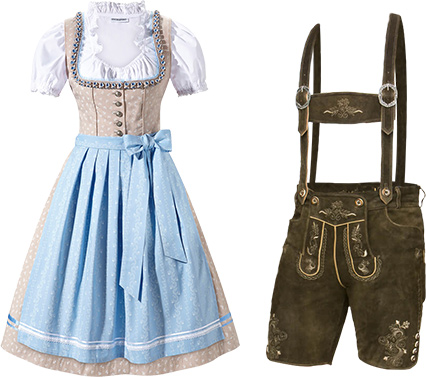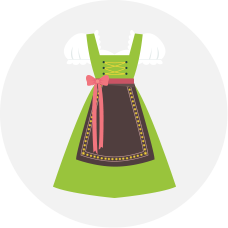
The Great Big Guide to Bavarian clothing Everything you need to know about lederhosen and dirndls
Find out more“Tracht”: tradition meets trend
In recent years, traditional Bavarian clothing has had something of a revival and is now more popular than ever. Called Tracht in German, this distinctive form of dress was once worn day in, day out by men, women, and children in the Alpine regions of Bavaria and Austria. For men, the most recognisable element is, of course, the lederhosen; for women, the dirndl is the most typical piece. In recent years, wearing Tracht has become a major part of the festivities at the Munich Oktoberfest.
It’s not just at the world-famous Wiesn that lederhosen and dirndls are worn, though. Many towns and villages have local festivals at which locals don traditional outfits, as do they for special occasions such as Christmas or weddings. After all, an ornate dirndl is the perfect wedding dress and a way of perpetuating tradition down the ages. Take a look at our online shop to find Tracht outfits – not just for weddings, either!
Keep reading this guide to find out everything you need to know about traditional Bavarian clothing. Just click on the chapter you’re interested in, or start here and read it from start to finish!

“German” lederhosen and dirndls
The most important distinction to make at the beginning is between authentic historic dress and the Bavarian fashion available today. Genuine Tracht is a strictly defined form of dress which differs between various parts of Bavaria and Austria – and which is only rarely worn in its original form.
It’s also important to remember that there is actually no such thing as “German” lederhosen and dirndls: they are worn only in Bavaria in the south of Germany and across the border in Austria. Germans elsewhere have little more to do with Tracht than people from other countries do.
Women’s wear revolves around the dirndl, a traditional dress with a structured bodice, tightly tied and decoratively embroidered. The lederhosen worn by men are generally made of goat or buckskin and also feature patterning. Traditionally, they are worn with over-shoulder braces, characteristically joined across the chest by a decorative panel.
Chapter 1 The dirndl (plus aprons, shoes, etc.)
What is a dirndl?
What exactly do we mean when we talk about a dirndl? The word refers to a form of dress which dates back to the 19th century and grew out of the traditional clothing worn by farmers in Austria and Bavaria. A dirndl is always composed of at least two pieces – the dress itself and an apron; in most cases, a cropped dirndl blouse is worn under the bodice and covers shoulders and upper arms. As a general rule, the bodice is tight while the skirt is cut wider and gathered at the waist, falling in pleats.
Today’s fashion dirndls offer the choice between various shapes and styles: you can opt for a fully traditional look or go for something more contemporary with a broader range of colours, patterns, and details. In terms of fabrics, most dirndls are made of cotton, linen, or velvet; the most exclusive designer dirndls may also use silk or even leather. The apron tends to be made of the same fabric as the dress, but may also be of silk or finished with lace trimming.

What you need for a perfect dirndl outfit










Dirndl
A dirndl is always made up of a dress and an apron; in most cases, you also wear a dirndl blouse underneath the low-cut bodice of the dress. Some dirndl dresses feature higher bodices and can be worn as two-pieces without a blouse; otherwise, you will need to remember to add a blouse to your dress and can choose between short puff and elbow-length sleeves.
Speaking of length, there are various skirt lengths to choose from, too: mini, midi, and full-length. They are usually sold with aprons of matching length – but you’ll need to tie the apron yourself (and how you tie it says a lot about you…)
Dirndl blouse
There is a wide range of dirndl blouses, but most of them are white or ecru (undyed); black blouses are sometimes worn with black dirndls for special occasions. The most common material for dirndl blouses is cotton batiste, but thicker weaves, linen, and even silk can also be used for added elegance. As a general rule, dirndl blouses have a décolleté neckline to show off cleavage; sleeves may be longer, however, going down to elbow or even full length in winter.
Dirndl blouses also frequently feature embroidery, openwork, and lace elements. To make sure they fit with the tight bodice of the dress, many dirndl blouses are cropped below the bust and held in place with a sewn-in elasticated band.
Dirndl shoes
Shoes are an important part of any dirndl outfit. There is no special type of dirndl shoe, however: it’s the style of the dirndl which determines what kind of shoe suits best. Whether flat-heels or pumps, the colours should match and the shoes should feature traditional Bavarian details such as bows or buckles. Boots work well with some of the country-style dirndls, too.
Once you’ve found the right shoes, you’ll need to think about tights or stockings. Why not try something different like lace or patterned tights? This is the perfect time to move away from sheer and experiment with openwork, netting, or embroidery: use your hosiery to add to the effect of your shoes – and the outfit overall.
Dirndl handbags
No dirndl outfit is complete without the right accessories – especially not without a handbag for your keys, phone, and cosmetics. Small, square or heart-shaped handbags are Oktoberfest classics: they’re generally made of leather or felt and so can take some punishment, but also feature pretty embroidery on the flap. Look out for a shoulder strap so that you can keep your hands free while keeping your bag on your body.
Alternatively, if you’re planning to spend the whole day at the Oktoberfest, you can opt for a matching backpack. Dirndl rucksacks don’t work well as part of elegant evening wear, though, so you might be better off with a small clutch. Whichever option you go for, try to keep your bag, your shoes, and the dirndl itself colour-coordinated.
Dirndl necklaces
The right jewellery is another important part of a dirndl outfit. One of the best looks is a snug-fitting satin neckband with a pendant at the front; called a Kropfband, this kind of choker is a classic in Bavarian jewellery, as are delicate multi-layered silver chains featuring charms – known as Charivaris and worn across the front of the dirndl bodice.
Besides silver, many contemporary styles use small semi-precious stones as beads; be careful with pearl necklaces, though, which only really suit the most elegant of evening dirndls. Moreover, make sure your necklace isn’t too long, as low-hanging jewellery clashes with the décolleté neckline of most dirndls.
Dirndl jackets
Having the right jacket for your dirndl can make a big difference – especially during cooler weather at the Oktoberfest – and really complete an outfit. There are various options, starting at the top of the scale with a traditional Janker made of loden (broadcloth) or wool.
For a less formal look, there are a ranged of knitted cardigans made to match dirndls. Blazer-style jackets in velvet or brocade offer another way of setting off a smart dirndl. As a general rule, cardigans for dirndls are short, stopping at the waist, and many feature standing collars. Most have buttons (zips are unusual) and should be colour-coordinated to match the dirndl.
Hair accessories
Donning a dirndl is a great opportunity to do something different with your hair. Typical hairstyles include plaits woven with velvet or satin ribbons, braids bunched into buns, and up-dos using hairpins which pick up on colours in the dirndl and often feature small gemstones or other traditional elements (and, ideally, match other items of jewellery such as earrings).
You can also add hair slides and hair clips with typical Tracht design elements to any hairstyle or, if you wear a ponytail, pep up hairbands with velvet bows. Wreaths are another stylish addition to a dirndl outfit, while hairbands look very fetching worn with short hair. A word of caution, though: don’t go overboard, as the dirndl itself is a striking piece of clothing from which it would be a shame to detract.
Dirndl bracelets
Round off your jewellery with a dirndl bracelet which matches or at least shares style characteristics with your necklace. A dirndl bracelet sits flush on the wrist, is usually silver, and often features charms or beads. Some are also made of small semi-precious stones threaded onto an elasticated band.
If you wear a watch, then try complimenting with a slender bracelet while you wear a broader, more striking piece on your other wrist (usually the right hand). Other options are velvet bracelets or, for the most rustic styles, leather bands.
Dirndl bras
There is no way round it: you will almost certainly need a special bra to wear with your dirndl. Bras developed specifically for dirndls shape your bust to give you the luscious cleavage you need in the same way as a push-up bra. They are generally wired and, if you would like to further accentuate your bust size, then opt for a padded version and add an inch or so on the quiet…
Dirndl bras for ladies with an ample bosom concentrate on shaping the bust to create an attractive décolleté while toning down size in other areas. The most common colour for dirndl bras is white to avoid them showing through; some models are intended to be seen, however, and so feature decorative stitching.
Tying your apron :
What is the right way to knot your dirndl apron?

In a relationship

Virgin

Single

Widowed/waitress
Left, right, or in the middle? How you tie the knot on the waistband of your apron says more about you than you might think! A vestige of historical Tracht which showed the marital status of the woman wearing it, the apron knot nowadays is a kind of not-so-secret code.
Where you tie your apron knot signals your relationship status to the people around you. If you wear the knot on the right, that means that you are either married, engaged to be married, or in a relationship; tying your apron on the left shows that you are single. An apron knotted squarely in the middle shows that the wearer is a virgin.
Since the way an apron is tied sends signals, you can use your knot to either encourage or discourage flirting – especially at the Oktoberfest, where many festival-goers are on the look-out for ladies with their knots on the left-hand side... On that note: tying the apron at the back says that you are widowed or working as a waitress. Whichever side you wear it on, aim for a big bow that is nevertheless knotted tight enough to hold.

